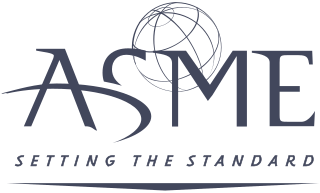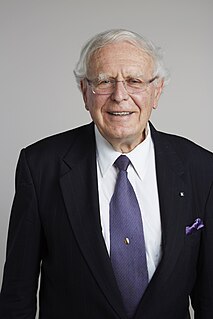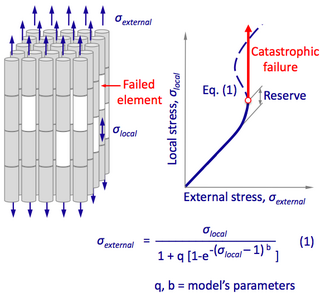Related Research Articles

A flange is a protruded ridge, lip or rim, either external or internal, that serves to increase strength ; for easy attachment/transfer of contact force with another object ; or for stabilizing and guiding the movements of a machine or its parts. The term "flange" is also used for a kind of tool used to form flanges.

The American Society of Mechanical Engineers (ASME) is an American professional association that, in its own words, "promotes the art, science, and practice of multidisciplinary engineering and allied sciences around the globe" via "continuing education, training and professional development, codes and standards, research, conferences and publications, government relations, and other forms of outreach." ASME is thus an engineering society, a standards organization, a research and development organization, an advocacy organization, a provider of training and education, and a nonprofit organization. Founded as an engineering society focused on mechanical engineering in North America, ASME is today multidisciplinary and global.

Within industry, piping is a system of pipes used to convey fluids from one location to another. The engineering discipline of piping design studies the efficient transport of fluid.
Romesh C. Batra is the Clifton C. Garvin Professor of Engineering Science and Mechanics at Virginia Polytechnic Institute and State University, Blacksburg, Virginia. He was born in Village Dherowal, Punjab, India. His family migrated from Dherowal to Shahabad Markanda, Haryana, India after India became an independent country. Dr. Batra has authored the book, “Elements of Continuum Mechanics”, AIAA. His research group has published in reputable refereed and widely read journals more than 400 papers of which about 40 are single-authored and nearly 300 have two authors; these are documented on the website http://www.beam.vt.edu/batra
Nominal Pipe Size (NPS) is a North American set of standard sizes for pipes used for high or low pressures and temperatures. "Nominal" refers to pipe in non-specific terms and identifies the diameter of the hole with a non-dimensional number. Specific pipe is identified by pipe diameter and another non-dimensional number for wall thickness referred to as the Schedule. NPS is often incorrectly called National Pipe Size, due to confusion with the American standard for pipe threads, "national pipe straight", which also abbreviates as "NPS". The European and international designation equivalent to NPS is DN, in which sizes are measured in millimetres, see ISO 6708. The term NB is also frequently used interchangeably with DN.
George Rankin Irwin was an American scientist in the field of fracture mechanics and strength of materials. He was internationally known for his study of fracture of materials.
Dr. Ramulu Mamidala is a mechanical engineering professor at University of Washington. Usually goes by the name 'Ram', or 'M.R.', he is recognized for his leadership and outstanding record in promoting collaborative education and research with industry. He is currently the director of Manufacturing Science and Technology Laboratory (MSTL) at Mechanical Engineering Department, University of Washington. He has designed and developed manufacturing methods for a wide range of systems, from the B2 bomber to the Boeing 787. Additionally, in collaboration with industry, he established and directed two interdisciplinary graduate educational programs in engineering and management and a certificate program in composites tooling and manufacturing. His exemplary collaborative efforts motivated working engineers to pursue doctoral studies and he is a leader in using emerging technologies in distance education to reach non-traditional students.

Zdeněk Pavel Bažant is McCormick School Professor and Walter P. Murphy Professor of Civil Engineering and Materials Science in the Department of Civil and Environmental Engineering at Northwestern University's Robert R. McCormick School of Engineering and Applied Science.
James Robert Rice is an American engineer, scientist, geophysicist, and Mallinckrodt Professor of Engineering Sciences and Geophysics at the Harvard John A. Paulson School of Engineering and Applied Sciences,.
Thermo-mechanical fatigue is the overlay of a cyclical mechanical loading, that leads to fatigue of a material, with a cyclical thermal loading. Thermo-mechanical fatigue is an important point that needs to be considered, when constructing turbine engines or gas turbines.
Morton E. Gurtin is a mechanical engineer who became a mathematician and mathematical physicist. He is an emeritus professor of mathematical sciences at Carnegie-Mellon University, where for many years he held an endowed chair as the Alumni Professor of Mathematical Science. His main work is in materials science, in the form of the mathematical, rational mechanics of non-linear continuum mechanics and thermodynamics, in the style of Clifford Truesdell and Walter Noll, a field also known under the combined name of continuum thermomechanics. He has published over 250 papers, many among them in Archive for Rational Mechanics and Analysis, as well as a number of books.

Structural fracture mechanics is the field of structural engineering concerned with the study of load-carrying structures that includes one or several failed or damaged components. It uses methods of analytical solid mechanics, structural engineering, safety engineering, probability theory, and catastrophe theory to calculate the load and stress in the structural components and analyze the safety of a damaged structure.

Jan Drewes Achenbach was a professor emeritus at Northwestern University. Achenbach was born in the northern region of the Netherlands, in Leeuwarden. He studied aeronautics at Delft University of Technology, which he finished with a M.Sc. degree in 1959. Thereafter, he went to the United States, Stanford University, where he received his Ph.D. degree in 1962. After working for a year as a preceptor at Columbia University, he was then appointed as assistant professor at Northwestern University.
Ken P. Chong is a Research Professor at The George Washington University and a former associate at the National Institute of Science and Technology (NIST). He was the Engineering Advisor, Interim Division Director and program director of Mechanics and Materials at various times for 21 years at the U.S. National Science Foundation. He has published over 200 refereed papers, and is the author or coauthor of twelve books including "Elasticity in Engineering Mechanics", "Intelligent Structures", "Modeling and Simulation-Based Life Cycle Engineering", "Mechanics of Oil Shale", and "Materials for the New Millennium". He has taught at the University of Wyoming, University of Hong Kong, University of Houston, and George Washington University [www.gwu.edu/] and had been visiting professor at MIT and University of Washington.
Palle Rama Rao FREng is an Indian scientist noted for his contribution to the field of Physical and Mechanical Metallurgy. He has collaborated and conducted research activities for over dozen universities and associations all over India and abroad. He has been honoured with the titles of Padma Vibhushan in 2011 by president of India for his contributions to scientific community. He is acting as the chairman, Governing Council, International Advanced Research Centre for Powder Metallurgy & New Materials (ARCI), Hyderabad.

Professor Bhagavatula Dattaguru is an Indian engineer and academic. He has received several awards, including the Padma Shri Award, India's fourth highest civilian honour in 2005 in the field of science and engineering.
Elmer Otto Bergman was an American civil, mechanical and consulting engineer at the University of Colorado and at C. F. Braun & Company, later KBR Inc. He served as the 83nd president of the American Society of Mechanical Engineers in the year 1964-65.
Reginald Irenee Vachon was an American mechanical engineer, business executive, lawyer and inventor, known as former president of the American Society of Mechanical Engineers.

Filippo Berto is an Italian professor and engineer.

Somnath Ghosh is the Michael G. Callas Chair Professor in the Department of Civil & Systems Engineering and a Professor of Mechanical Engineering and Materials Science & Engineering at Johns Hopkins University (JHU). He is the founding director of the JHU Center for Integrated Structure-Materials Modeling and Simulation (CISMMS) and was the director of an Air Force Center of Excellence in Integrated Materials Modeling (CEIMM). Prior to his appointment at JHU, Ghosh was the John B. Nordholt Professor of Mechanical Engineering and Materials Science & Engineering at The Ohio State University. He is a fellow of several professional societies, including the American Association for the Advancement of Science (AAAS).
References
- ↑ "SAM Y. ZAMRIK '61g, '65g: Biographical Sketch," at trustees.psu.edu, 2012. Accessed 2017-09-22.
- ↑ The Alcalde. Vol. 85, nr. 2 (Nov 1996), p. 41
- ↑ Sam Y. Zamrik Honored For a Lifetime of Service to Engineering at asme.org , Oct. 26, 2010. Accessed 2017-09-22.